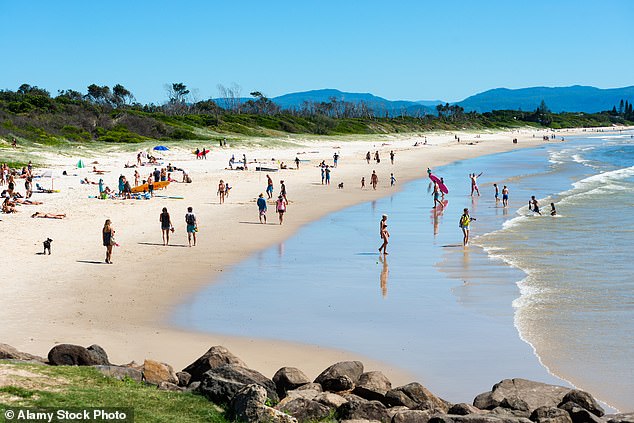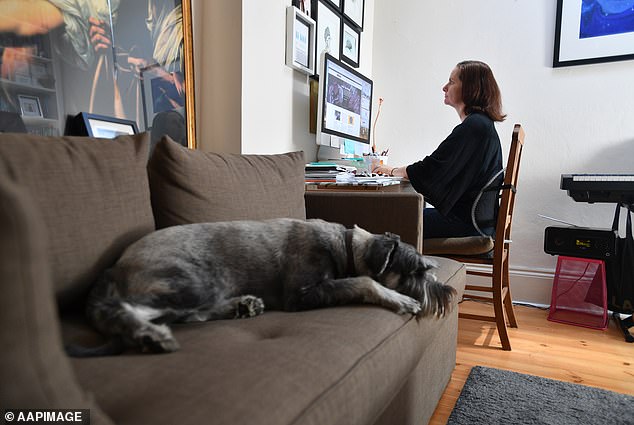The proof the Covid seachange work-from-home dream is dying as building approvals plunge in regional areas
New data shows fewer Australians are working from home in regional areas, while the number of building permits outside capital cities is declining.
Qi Chen, CEO and founder of land sales site OpenLot, said professionals are no longer embracing the changing lifestyle as they did during the pandemic.
This is despite a dramatic drop in construction costs, which are now rising at their slowest pace in two decades after some dramatic post-COVID spikes.
“The gravity is shifting back to the big cities,” Chen said.
‘The dream of living in a boom town or a sea change city has lost its luster in the Covid era.
‘Nowadays, people want to live as close to the capital as possible, but still have a house.’
The number of new home approvals fell across all states last fiscal year as more employers called their workers back to the office.
Well-known marine change hotspots such as Byron Bay and the Sunshine Coast in Queensland were among the coastal hotspots that experienced double-digit declines.
Fewer Australians are now embracing working from home in regional areas as building permits fall outside capital cities, new data shows

During the last financial year, the number of new House of Representatives approvals in the regional areas of each state (pictured is Byron Bay) declined
But new home approvals rose in almost all state capitals except Sydney and Adelaide.
“Last year, the number of housing permits grew significantly faster in metropolitan areas than in regional areas,” Chen said.
In Queensland, Brisbane saw an 8.78 per cent increase to 12,774 new homes approved, but in the regions approvals fell by 8.99 per cent to 8,779 homes.
On the Sunshine Coast, which includes Noosa and Caloundra, new home approvals fell 17.22 per cent to just 2,129 projects.

Qi Chen, the CEO and founder of land sales site OpenLot, said professionals were no longer embracing the changing lifestyle as they did during the pandemic
In Cairns, in the state’s tropical north, the number of new homes fell by 10.56 percent to 983.
Even the Gold Coast, a popular city for those fleeing Sydney, saw a decline, with new home approvals falling 2.09 per cent to 1,122 homes.
In Sydney, by far Australia’s most expensive housing market, the number of new homes sold fell 8.89 per cent to 12,474, with demand expected to fall in 2024-25.
“Metro Sydney has a land supply problem because the topography doesn’t allow for the construction of large numbers of new homes,” Chen said.
“The market is moving more towards medium and high density developments, so we expect new home sales to slow.”
But in regional areas of New South Wales, the number of housing development approvals fell 9.33 per cent to 10,037.
The Richmond-Tweed area, which includes Ballina and Byron Bay, was among the worst hit in the state, with a dramatic 23.59 per cent decline, with just 502 new homes approved.
The Shoalhaven region, which includes Nowra on the South Coast and the Southern Highlands towns of Bowral, recorded a combined decline of 19.7 per cent to 583 new housing permits.
The urban-rural gap was greatest in Western Australia.
Perth, a city facing a large influx of migrants from other states, saw 12,575 housing approvals in the year to June, a 24.63 per cent increase.
But in regional areas in Western Australia there was a 1.05 percent decline to 2,449 homes.

Fewer Australians are now embracing working from home in regional areas as building permits fall outside capital cities, new data shows (pictured is an Adelaide professional)
Melbourne has been Australia’s weakest capital city market since the pandemic.
However, there was still a two percent increase in the number of new home approvals, to 24,352, as demand increased due to migration from abroad.
However, in regional Victoria, the number of building permits fell dramatically by 13.09 per cent to 9,085.
On the Mornington Peninsula, an hour’s drive from Melbourne, approvals fell 20.31 percent to 675.
In South Australia, new home approvals in Adelaide fell 5.62 per cent to 6,942. However, outside the state’s only major population centre, there was a 13.2 per cent drop to 1,999.
OpenLot analysed data from the Australian Bureau of Statistics on new home approvals and compared the years 2022-2023 with the years 2023-2024.
The figures mainly relate to private homes for which permission from local authorities was required to proceed with construction.
The number of new construction approvals in the region is falling, despite the fact that the Cordell Construction Cost Index shows that construction costs rose by just 2.6 percent in the last fiscal year, the smallest annual increase since 2002.
An earlier post-COVID surge in construction costs has paralysed the construction sector, with construction companies accounting for more than a quarter of all bankruptcies in 2023-24.
The Reserve Bank’s 13 rate hikes in 2022 and 2023 were the most dramatic since the late 1980s. In August, the cash rate remained unchanged at a 12-year high of 4.35 percent.
